
Feel free to add tags, names, dates or anything you are looking for
Among numerous wall paintings preserved in the Tao Klarjeti historical region of Medieval Georgia (now in north-eastern Turkey), the earliest example is displayed in the Church of Otkhta Eklesia (Dőrt Kilise in Turkish), a three-nave basilica dating from the late tenth century. It was commissioned by King Davit Kurapalatos (†1001), one of the preeminent rulers from the Bagrationi royal family in the 960s, and underwent several alterations in the 970s.The history of Otkhta Eklesia Lavra (monastery complex) is closely connected with the activities of the Bagrationi royal family, as well as with the outstanding Georgian theologians and monks St. Ioane and St. Ekvtime Athoneli, St. Ioane-Tornike among others, who founded the Iviron Monastery on Mount Athos in the 980s, as attested by St. Giorgi Mtasmindeli (the Hagiorite).
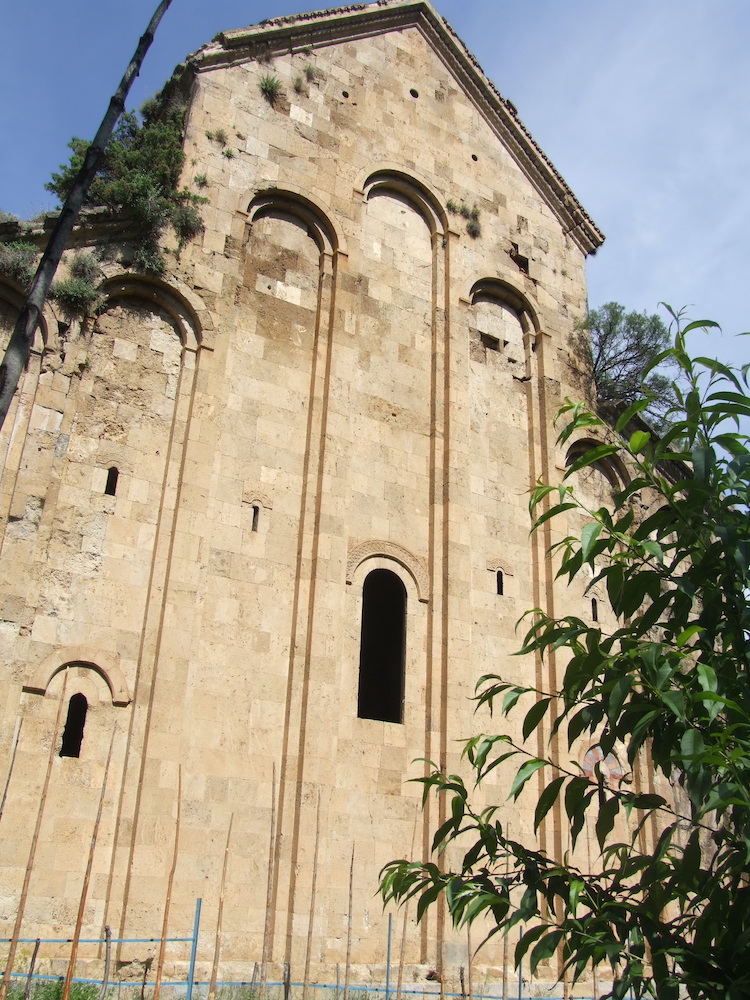
Otkhta Eklesia, eastern facade, late 10th c.
Otkhta Eklesia Lavra is located in a beautiful gorge surrounded by mountains, cliffs and forests. Along with the main church, ruins and remnants of different monastic buildings survive.
As was common during that period, wall painting adorns only the sanctuary of this grand church. However, the very sophisticated program of painting created a basis for future full-scale paintings.
Otkhta Eklesia, interior
The sanctuary is comprised of five tiers divided by wide ornamental bands. In the conch of the apse there is a grand composition of the Majestas Domini – a large figure of Christ surrounded by an oval mandorla and celestial hosts. Unfortunately, this section is extremely defaced, and the details can barely be made out. Nevertheless, the Blessing Hand of God and a flying Dove (the Holy Spirit) can be seen above Christ’s head.
Underneath, there is a very narrow tier bearing a row of kneeling angels approaching from either side, and a representation of the Hetoimasia in the center. It seems that this register was corrupted during the reconstruction works that were carried out on the upper parts of the building (between 978 and 1001), which damaged this part of the murals, including the Georgian inscription.
Otkhta Eklesia, murals in the sanctuary, late tenth c.
The next register contains a figure of the Virgin in the center standing on a pedestal in the orans posture, and accompanied by two angels and two groups of Apostles on either side. One specific detail is a figure of St. John the Baptist next to the right angel, whose upraised right hand is pointing to the Vision of Christ in the conch. Given that this row of Apostles with the figure of the Virgin in the center is located right under the image of the Hetoimasia and the Dove – the Holy Spirit – seated on it, conveys an allusion to the Descent of the Holy Spirit as well as to the Ascension and the Second Coming, as highlighted by the Georgian inscriptions on the scrolls of the angels.
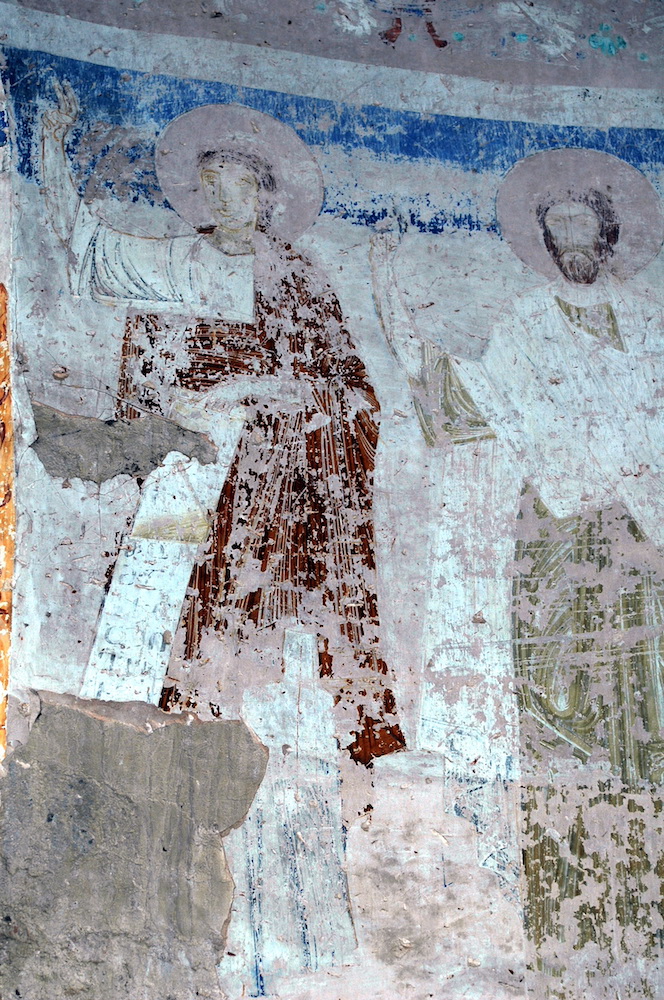
Apostles, sanctuary
The most expressive and best visible is the third register, which is interrupted by the large eastern window. The opening is so wide that it seems to be a continuation of the apse walls. The composition of this tier, and above all of the window intrados, is the focus of the entire program: in the semi-spherical part of the window there is a half-figure of a woman depicted holding a model of the basilica (a copy of the Otkhta Eklesia in almost every detail) in one hand and wearing a building-shaped crown on her head, surrounded by lavish floral ornaments that resemble the Horn of Prosperity. The inscription in the old Georgian script Asomtavruli defines the figure as Zion. In fact, it is a personification of the Mater Ecclesia – the Mother of all Churches. Given her golden halo with the sign of the Cross, an implication of the Second Person of the Trinity – i.e. Jesus Christ becomes evident, and also connotes the idea of St. Sophia – the Wisdom of God.
Personification of Zion, sanctuary window

Personification of Zion, model of Otkhta Eklesia
On the jambs of the window, two figures are depicted – that of the prophet Melchizedek on the north side and that of the prophet Moses on the south side. It is indicative that these two persons represent the Eucharist (Melchizedek) and Law (Moses). Melchizedek (some scholars believe that this figure depicts Aaron), stands frontally before a mountain or a curtain holding a tray, presumably containing bread and wine (the Eucharist). However, it is now difficult to discern the original drawing.
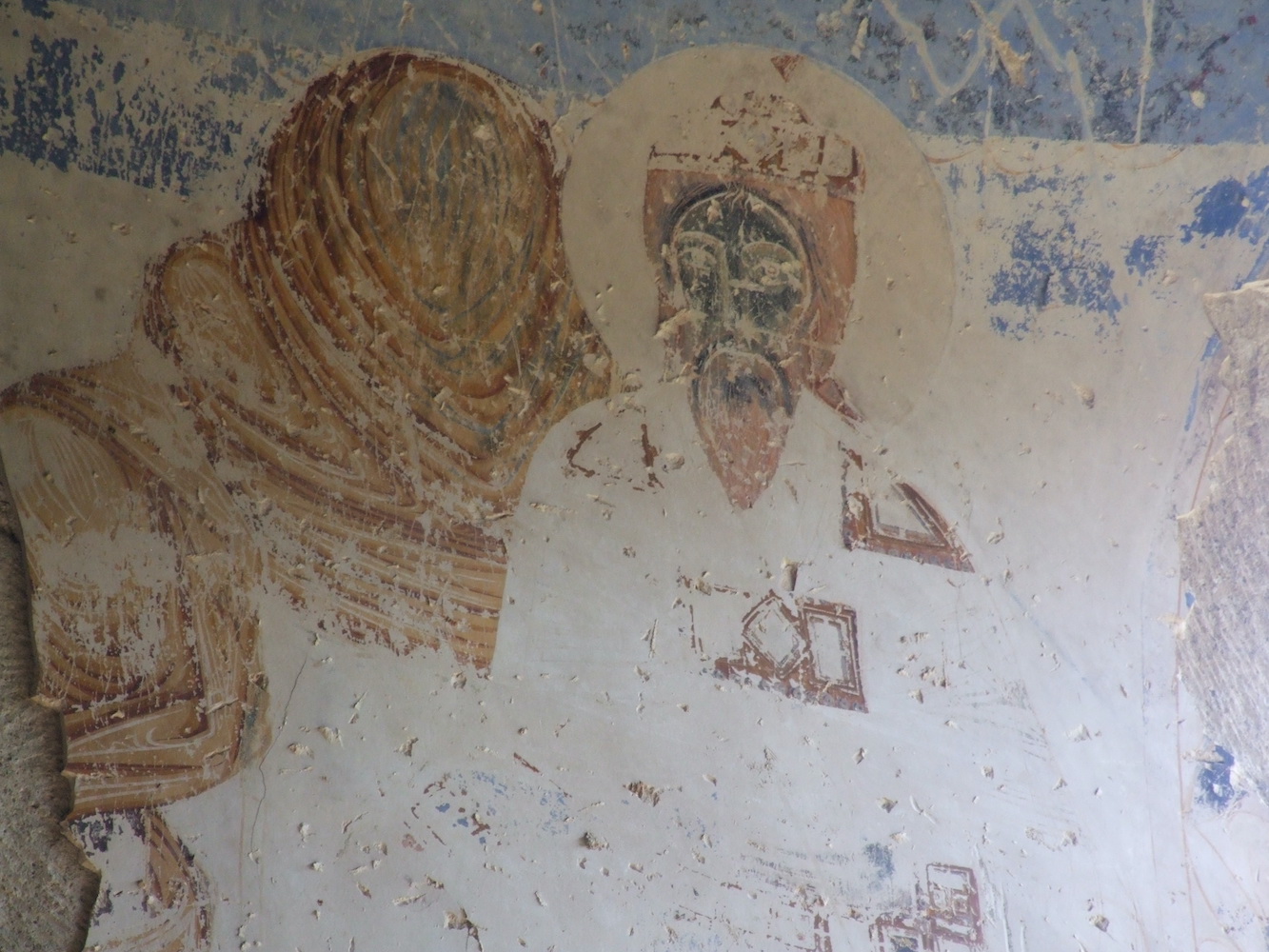
Prophet Melchizedek, sanctuary window
Moses is depicted standing in front of the flaming mountain (Sinai) with his face turned back, and his hands stretched towards the Hand of God that is giving him the Scroll of the Law (the Ten Commandments). This tripartite composition represents the idea of the Eklesia (Church) in its different aspects, while at the same time producing a wonderful coloristic and linear image.
The figures of Melchizedek and Moses appear to continue the row of Prophets and Holy Bishops that are portrayed in this register. It is noteworthy that the two figures flanking the window represent the prophet David and the prophet Solomon, biblical ancestors of Jesus Christ and legendary ancestors of the Bagrationi royal family – one of whom, King David Kurapalatos, was the commissioner and in a sense the author of this building and these murals, along with many other churches and monasteries in the Tao-Klarjeti region.
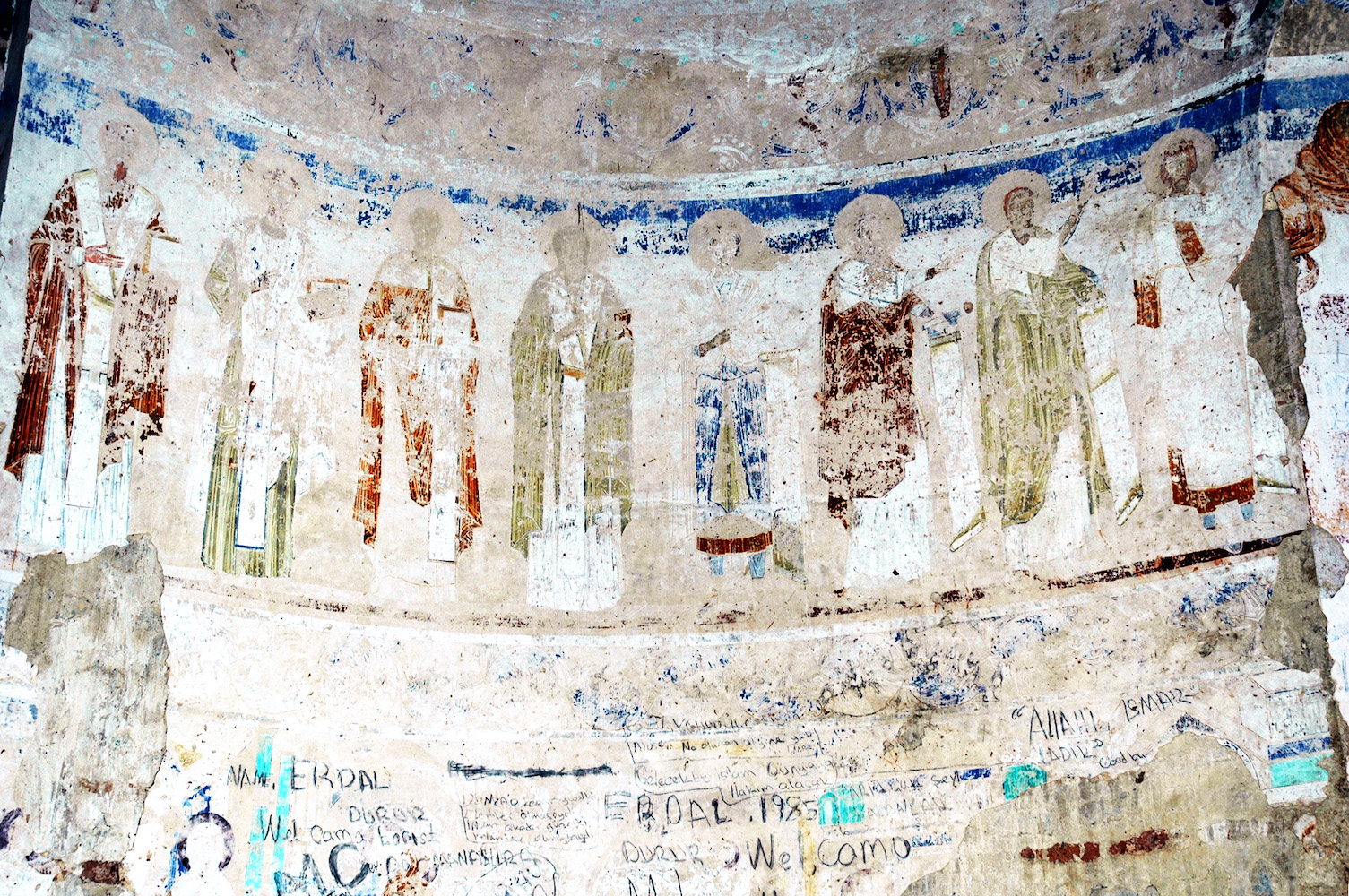
Prophets and Holy Bishops
Side by side with the Prophets, the figures of the Holy Bishops are represented: four of them on either side, thus underlining the idea of the Christian Church and Liturgy, as well as the unity of the Old and New Testaments.
The ornamental band dividing the register of Apostles and Prophets is rather wide, and penetrates into the window: framing the figure of Zion, and thus uniting the painting of the window with the register of the Prophets. The ornament represents the Horn of Prosperity, and is colored with glistening lazuli and turquoise pigments. It is more worthy of note that small, half-naked figures in short tunics are inscribed in the floral scrolls of the ornament, appearing like putti in very lively postures and dynamic movements, revealing a resemblance to classical and Hellenistic art.
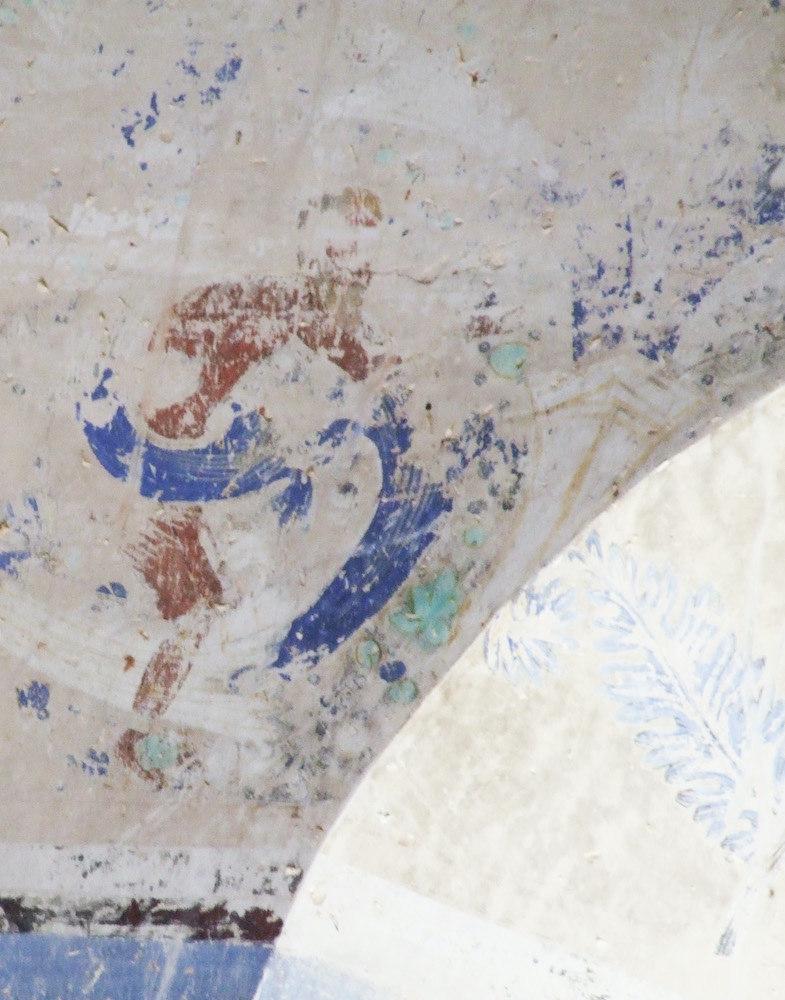
Ornamental band, fragment
At the bottom of the apse, in the lower tier there are scenes depicted from the Christological cycle – which is a rare example of such a design. There are nine scenes: the Annunciation, the Visitation, the Nativity, the Presentation at the Temple, the Baptism, the Raising of Lazarus (?), the Transfiguration, the Crucifixion, the Anastasis, the Holy Women at the Tomb and Christ before the Holy Women. These images are much more defaced and damaged than those in the upper registers. Most probably this part of the painting could not be observed from the naos because of the chancel barrier.
Even in its present neglected condition, it can be observed that the background of the scenes consisted of numerous architectural and landscape details resembling classical models. In some scenes, the Celestial segments are highlighted with multicolored stripes, featuring rare and beautiful turquoise pigments that stress the idea of Theophany. These scenes represent four main concepts: Incarnation, Theophany, Resurrection, and Salvation.
On the side wall of the central nave and the sanctuary pilasters there can be discerned pale shadows of figures, which may well have been the figures of ktetors from the Bagrationi family that were painted after reconstruction of the vault in the early eleventh century.
The main concept of the painting is the Eklesia – Church, and the key for this content is represented by the figure of Zion that includes the notions of St Sophia – the Wisdom of God, Mater Ecclesia, Celestial Jerusalem and the Virgin, and this is emphasized in every possible way. The figures of the prophet Moses and the prophet Melchizedek also stress the principal ideas of the Eklesia (Church) – Priesthood, Law and Eucharist. This concept is highlighted in the upper zones as well. In fact, the program represents the unity of the Celestial and earthly churches. The main message can be read from the bottom to the top: from the Incarnation and the Sacrifice in the lower zone, to the Christian teachings of the Prophets, the Holy Bishops and the Apostles, and then through the Hetoimasia and officiating angels to the Second Coming, and finally to the Eternal Salvation represented by the Majestas Domini in the conch. There are different assumptions regarding the name of the church: either Zion or St. Sophia.
The interior of the church is vast and grandiose, and the murals of the high sanctuary correspond to this impression: the overall design is extremely monumental, and the distribution of the rows is architectonic. The figures are mostly portrayed in frontal and static postures, with outlines that are distinct and well-defined. The figures stand out against the white-blue backgrounds; in many cases gold leaf was applied to the haloes. There are also surviving fragments of inscriptions in the old Georgian Asomtavruli script.
Notwithstanding the poor state of preservation, the high level of artistic rendering is quite obvious – especially the coloring based on white, blue, lazuli, emerald green, turquoise blue, and golden ochre in combination with the black outlines and expressive linear rhythm of the vestments’ draperies. The overall impression is one of grandeur, festivity, magnificence, and so forth.
The proportions of the figures are elongated, their postures solemn and even static. Only in the lower tier do the scenes of the Feasts reveal some sense of plastic rendering, curvilinear drawing and more dynamic poses, in contrast to the more graphic and linear rendering in the upper zones. The coloring of these scenes includes more blue and turquoise tones as well. The Hellenistic richness and lavishness of the ornaments create a contrast to the more static, graphic rendering of the figures.
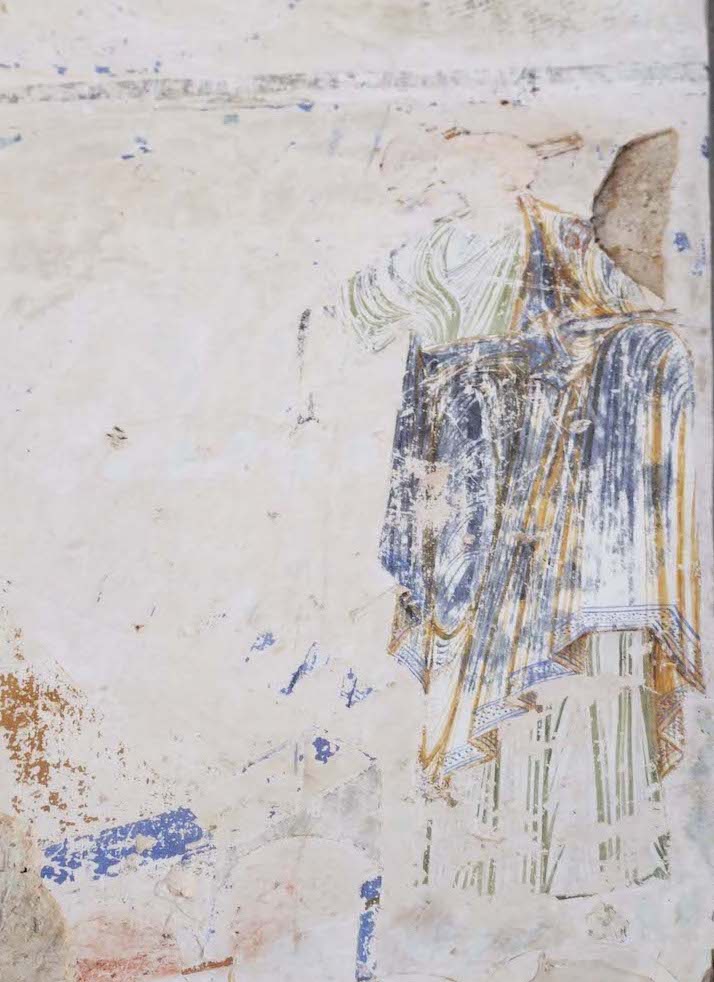
Christ appearing to the Holy Women
The program of the Otkhta Eklesia wall painting is quite unique, and parallels can rarely be found in Eastern Christian art that feature such an imposing design and sophisticated theological content or variety of themes. The composition of the sanctuary window with its personification of Zion in the window arch is particularly remarkable. This distinguished and unique content, along with the artistic rendering of the murals, attests to the existence of exceptionally advanced, original and creative traditions of arts and culture in this historic region of Medieval Georgia.